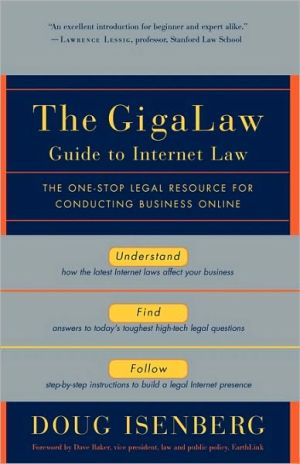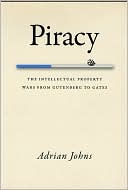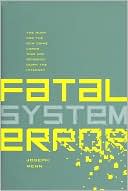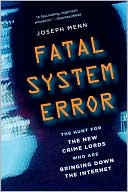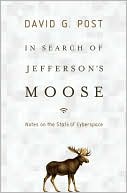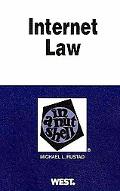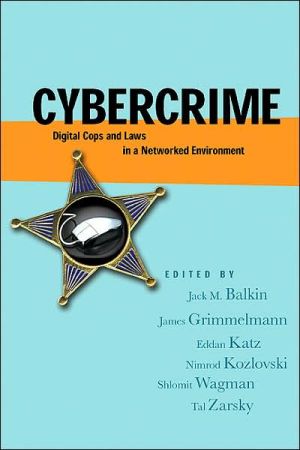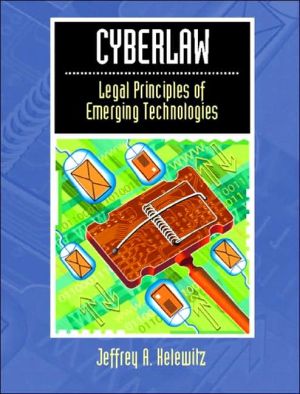Gigalaw Guide To Internet Law
Advance praise for The GigaLaw Guide to Internet Law\ “I read this book from cover to cover. The examples of case law are of enormous illustrative value. Some of them will raise your blood pressure (well, mine went up several notches, anyway). Well worth the time to read!” \ —Vint Cerf, chairman, Internet Corporation for Assigned Names and Numbers (ICANN)\ “Doug Isenberg pulls off the toughest hat trick in legal writing—he and his contributing authors map out the legal landscape of cyberspace...
Search in google:
Advance praise for The GigaLaw Guide to Internet Law I read this book from cover to cover. The examples of case law are of enormous illustrative value. Some of them will raise your blood pressure (well, mine went up several notches, anyway). Library Journal Isenberg is a practicing attorney, speaker, and founder of GigaLaw.com, a web site about Internet law. His new work is written for those who need to understand the laws applicable to electronic commerce. Isenberg reviews the laws on copyright, patent, trademarks, privacy, free speech, contracts, and employment in the context of online business. He reports on the way the courts and administrative agencies are construing the law by featuring the facts and disposition of prominent cases. The examples illustrate how electronic businesses can structure themselves for compliance. There is discussion of Canadian and European Union privacy rules. Several chapters are written by coauthors with expertise in disciplines such as patent or employment law. This covers some of the same territory as Dianne J. Brinson's Internet Law and Business Handbook, but it is valuable for treating recent developments. Highly recommended for business collections. Joan Pedzich, Harris Beach LLP, Rochester, NY Copyright 2002 Cahners Business Information.
CHAPTER ONE\ \ Case Study: An Introduction to Copyright on the Internet, Playboy v. Sanfilippo\ \ Playboy Enterprises, Inc.—yes, that Playboy—is one of the more active participants in Internet law, filing numerous lawsuits against people and companies that use the well-known adult entertainment publisher’s intellectual property in cyberspace without obtaining permission. Intellectual property includes copyrights (such as photographs of nude models) and trademarks (such as the “Playboy” and “Playmate” names); clearly, Playboy has a lot to protect online.\ \ There’s no denying that, on the Internet, the sex industry is quite popular. And in many ways the sex industry has been at the forefront of important Internet developments, including online payment systems, affiliate programs, innovative advertising techniques, and more. Playboy is among the tamer players in the online adult world, but its name is certainly among the best known, and it has a large library of high-quality content—which is important for the success of any publisher, particularly on the Web. But popularity has a downside, too. While imitation may be the greatest form of flattery, Playboy (like other publishers) is not in business to give away its content for free. So, when individuals and other companies have copied Playboy’s photos for their own websites—either by scanning images from the printed Playboy magazine or by copying images from Playboy’s site—Playboy has not hesitated to enforce its rights.\ \ One case in particular is especially interesting and enlightening and serves as a great introduction to theissue of copyright law and the Internet. The following facts are based on an opinion written by a federal judge in California and Playboy’s allegations in a case decided in 1998.1\ \ In the case, Playboy v. Sanfilippo, Playboy filed a lawsuit against Francesco Sanfilippo and his company, Five Senses, for copyright infringement. According to Playboy, Sanfilippo operated a website through which he provided and sold access to thousands of copyrighted photographs owned by Playboy. Sanfilippo’s website, like many adult sites with pornographic content, was divided into public and private sections. The public, or free, section advertised images available in the private area, which was accessible to those who bought a password from Sanfilippo.\ \ Playboy said it sent Sanfilippo a “cease and desist” letter in October 1996. These letters are often sent by copyright owners or their lawyers to people or companies who they believe have committed copyright infringement. The letters, sometimes known as “demand letters,” typically inform a person or company that it is committing copyright infringement and demand that the action come to an immediate stop. Sending a cease and desist letter is usually, but not always, a wise precursor to filing a lawsuit, because doing so often scares the recipient into complying without incurring the costs, angst, and uncertainty of courtroom litigation.\ \ Two days later, Playboy’s attorney sent another demand letter to Sanfilippo. According to Playboy, Sanfilippo immediately acknowledged that some of the images on his website were scanned directly from Playboy’s magazine; he did not dispute that Playboy owned the copyright in the images; and he agreed to promptly remove them from his site. However, Sanfilippo did not do so, and Playboy’s attorney later sent another cease and desist letter, after which Sanfilippo said he would remove the images within twenty-four hours—which he did not do. Instead, by February 1997, the site still displayed Playboy’s photos and even offered for sale CD-ROMs containing the pictures.\ \ Fed up with Sanfilippo’s continued defiance of Playboy’s legal demands, Playboy filed a federal lawsuit in April 1997. Playboy alleged that Sanfilippo’s website contained twenty-seven files of its images, for a total of 7,475 pictures! Playboy sought and obtained from the court a temporary restraining order and an order of seizure; within two weeks, Playboy and Sanfilippo agreed to a preliminary injunction—a court requirement that prevented Sanfilippo from using the images until the lawsuit was resolved. Playboy then filed a motion with the court asking for a “summary judgment,” a court order that there are no genuine issues of material fact to be decided in a lawsuit and that one party is entitled to judgment as a matter of law. In other words, a court will grant a summary judgment motion only in an obviously lopsided case.\ \ To prevail on a claim for copyright infringement, the court in the Sanfilippo case noted that a plaintiff must prove two things: (1) that it owns a valid copyright, and (2) that the defendant violated one of the copyright owner’s “exclusive rights” listed in the U.S. Copyright Act.2 As to the first requirement, the court found that there was no factual dispute that Playboy owned the copyright rights in the images on Sanfilippo’s website, because even he admitted as much. As to the second requirement, the court said Sanfilippo admitted copying sixteen files directly from a third-party source onto his hard drive without Playboy’s permission and that the additional eleven files were uploaded to his hard drive by someone else with Sanfilippo’s authorization. Because copying is clearly one of the exclusive rights listed in the U.S. Copyright Act (they don’t call it copyright law for nothing!), the court quickly concluded that Playboy was entitled to summary judgment for the 7,475 images.\ \ The court then turned to the issue of damages—that is, how much money Sanfilippo should be ordered to pay Playboy. Damages are an interesting concept in copyright law and, depending upon the facts, can serve a number of purposes: to take away any profit a defendant may have made by committing copyright infringement, to compensate a plaintiff for money he lost as a result of having his property infringed, or to punish a defendant for having broken the law. According to one provision of the U.S. Copyright Act, under certain circumstances a plaintiff is entitled to “statutory damages” for each act of infringement in an amount from $500 to $20,000, “as the court considers just.”3 And in cases where the defendant’s conduct was “willful,” that is, where he acted with knowledge that his conduct constituted copyright infringement, the court may “in its discretion” increase the damages amount to as much as $100,000 per infringement. (These figures, which applied at the time of the court’s opinion in 1998, since have been increased, as noted in Chapter 2.)\ \ Playboy argued that, with respect to nine of the twenty-seven files containing its images on Sanfilippo’s site, Sanfilippo’s copyright infringement was willful (and Playboy was therefore entitled to the higher statutory damages) because, among other things, Sanfilippo allegedly admitted in a deposition that he knew the copying and sale of Playboy’s photos amounted to copyright infringement. The court agreed.\ \ Playboy requested that the court enter an award in the staggering amount of $285,420,000! This figure was based on 1,699 images at $100,000 each (the maximum amount for “willful” copyright infringement) and 5,776 images at $20,000 each (the maximum amount for nonwillful statutory damages). Ultimately, the court found that an award of only $500 per image was “sufficient to adequately compensate [Playboy] and deter any future infringement by [Sanfilippo]”—but that still totaled $3,737,500.\ \ The lessons from this case should be clear:\ \ • Under U.S. copyright law, it is illegal to copy someone else’s photographs, without permission, and publish them on your website. As we’ll see in later chapters in this book, copyright law protects many other types of works, too, in addition to photographs.\ \ • If you commit copyright infringement by publishing someone else’s property on your website, you are exposing yourself to the world. In the past, some people may have been able to get away with copyright infringement because the copyright owner was unaware of what was happening—such as if someone copied photos and used them in a newspaper advertisement in one city. Because the World Wide Web is, as its name implies, available worldwide (except, of course, in those countries where the technology is unavailable or the government forbids it), copyright scofflaws are less likely to go undetected.\ \ • If you are a copyright owner, you can successfully sue a cyberspace infringer.\ \ • If you are a copyright infringer, you should respond to a demand letter—and take appropriate steps to right your wrong. If you don’t, a copyright lawsuit could prove quite expensive.\ Copyright 2002 by Doug Isenberg
Author's NoteForewordIntroductionPt. ICopyright Law1Case Study: An Introduction to Copyright on the Internet, Playboy v. Sanfilippo32The Basics of Copyright Law83Creating a Copyright-Friendly Website214The Digital Millennium Copyright Act35Pt. IIDomain Names and Trademarks5Case Study: An Introduction to Domain Names and Trademark Disputes, Electronics Boutique v. Zuccarini496The Basics of Trademark Law557Traditional Trademark Law and Domain Names688The Anticybersquatting Consumer Protection Act779The Uniform Domain Name Dispute Resolution Policy8810Other Trademark Issues99Pt. IIIPatent Law11Case Study: An Introduction to Patents on the Internet, Amazon.com v. BarnesandNoble.com10912The Basics of Patent Law and Protection11413Patents for Software and Internet Business Methods12614Exploiting and Enforcing Patents141Pt. IVPrivacy15Case Study: An Introduction to Privacy on the Internet, Federal Trade Commission v. GeoCities15116Internet Privacy Laws and Privacy Policies15717General Privacy Laws17118The Children's Online Privacy Protection Act17619The European Union's Privacy Directive18620The Canadian Privacy Act195Pt. VFree Speech and the First Amendment21Case Study: An Introduction to Free Speech on the Internet, Zeran v. America Online20522Sex, the First Amendment, and the Internet21323Message Board Misconduct and Online Anonymity22724Critical Websites, Parody, and the First Amendment24125Hate on the Internet24826Spam259Pt. VIContract Law and High Technology27Electronic Signatures and the U.S. E-Sign Act27328Website Development Agreements27929Creating Contracts on the Internet287Pt. VIIEmployment Law30Case Study: An Introduction to Employment Law in the Technological Revolution, Strauss v. Microsoft29931Sexual Harassment30632The Age Discrimination in Employment Act32033The Americans with Disabilities Act32534Noncompete Agreements and Other Restrictive Covenants33735Privacy Issues and Employee Monitoring351Afterword360AppThe Fifteen Essential Internet Law Bookmarks364Contributors368Notes371Index386
\ Library JournalIsenberg is a practicing attorney, speaker, and founder of GigaLaw.com, a web site about Internet law. His new work is written for those who need to understand the laws applicable to electronic commerce. Isenberg reviews the laws on copyright, patent, trademarks, privacy, free speech, contracts, and employment in the context of online business. He reports on the way the courts and administrative agencies are construing the law by featuring the facts and disposition of prominent cases. The examples illustrate how electronic businesses can structure themselves for compliance. There is discussion of Canadian and European Union privacy rules. Several chapters are written by coauthors with expertise in disciplines such as patent or employment law. This covers some of the same territory as Dianne J. Brinson's Internet Law and Business Handbook, but it is valuable for treating recent developments. Highly recommended for business collections. Joan Pedzich, Harris Beach LLP, Rochester, NY Copyright 2002 Cahners Business Information.\ \
